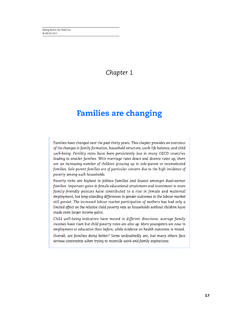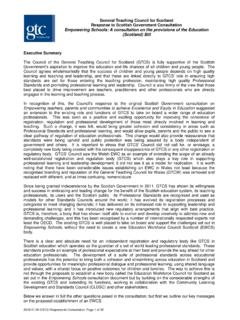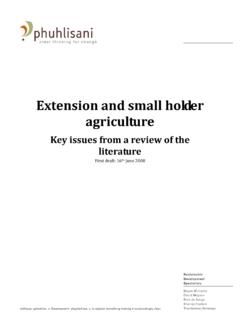Transcription of Ageing OECD Societies
1 ISBN 978-92-64-04661-0 Trends Shaping Education OECD 2008 Ageing OECD Societies FEWER CHILDREN LIVING LONGER changing AGE STRUCTURESThe notion of Ageing Societies covers a major set of trends about populations which include, but go well beyond, the fact that people now live longer. It is equally about numbers of children and babies, and what goes on within families. These big trends have profound and direct impacts on schools, and we focus on three related aspects:There are fewer and fewer children being born in OECD Societies . MWe are living longer. MThere is a new shape to the population distribution as numbers in the different age Mgroups can show these trends accurately to the present day but forecasting the future is altogether more difficult.
2 For example, many more people may die young than could have been expected at any given time (through wars or a pandemic like HIV/AIDS). Behaviour can shift unpredictably and with it long-term historical trends, such as the half of child-bearing couples worldwide who now use contraception which would have been difficult to predict as recently as the 1960s, when just 1 in 10 did , we include the most authoritative available population forecasts to gain a picture of the long-term changes taking 114 TRENDS SHAPING EDUCATION ISBN 978-92-64-04661-0 OECD 20081. Ageing OECD SOCIETIESFEWER CHILDRENT here have been rapid changes in the number of children being born, with births falling dramatically.
3 Families are smaller, women tend to be older when they have children, and more do not have children at all. Education is part of the story, with higher levels of education tending to be associated with fewer children. The number of children born in OECD countries is now so low that the long-term prospect is of population decline, despite the fact that we are living longer as discussed next. On average children per woman should be born in a country for there to be long-term population stability: when it is significantly lower than this the population falls. By the beginning of the 21st century, only two OECD countries Mexico and Turkey were still above the line.
4 This is in sharp contrast with many developing countries where fertility levels remain Birth rates well down on the 1960sTotal fertility rates: children per woman aged 15-49, 1960, 1980 and 2003876543210196019802003 TurkeyMexicoUnited StatesIcelandIrelandNew ZealandFranceNorwayAustraliaDenmarkFinla ndNetherlandsSwedenUnited KingdomLuxembourgOECDB elgiumCanadaPortugalSwitzerlandAustriaGe rmanyHungaryJapanItalySpainGreecePolandC zech RepublicKoreaSlovak RepublicS t a t Li n k 2 : OECD (2005), Health at a figure shows two key aspects about birth rates. One is change over the approximately 40 years since 1960.
5 The other is the relative position of the different OECD countries, ordered left to right from those with highest current birth rates to those with the lowest. We see just how significant has been the drop in birth rates. The OECD average was over 3 births per woman aged 15-49 years in 1960 which has been cut in half in only 45 years. For some countries, the fall in the number of children being born has been truly dramatic such as Korea, which has gone from one of the highest fertility rates of the 30 countries to one of the pattern which stands out is how similar the birth rates have now become across most countries, with around two-thirds of them belonging in the narrow range to births for each woman aged 15-49.
6 Compare this with the differences at the start of the 1960s, when some countries (Japan, Hungary, the Czech Republic) already had low birth rates of around 2 while others (Korea, Mexico, Turkey, Iceland, New Zealand) were more than twice as high. Some might be surprised to see Nordic countries to the left of the figure higher fertility and Southern European ones with lower fertility, to the Ageing OECD Societies TRENDS SHAPING EDUCATION ISBN 978-92-64-04661-0 OECD 2008 15 The second figure showing the age of mothers when they have their first child reinforces the picture.
7 It underscores the extent of recent change in social behaviour. In 1970, in only 3 of the 16 countries in the figure was the average age for starting motherhood 25 years or more; by 2004, in none of them was it less than 25. The mothers age on having their first child now approaches 28 years for the 16 countries whereas in 1970 it was 24 Starting parenthood laterAverage age when mothers have their first child in a number of OECD countries 3 WITZERLAND'ERMANY* ,UXEMBOURG3 WEDEN&RANCE$ENMARK'REECE&INLAND/%#$ #ZECH 2 EPUBLIC(UNGARY)CELAND0 OLAND3 LOVAK 2 EPUBLIC5 NITED 3 TATESS t a t Li n k 2 : OECD (2006), Society at a education?
8 School rolls fall as numbers of young people fall. For some countries that have been Mexperiencing severe teacher shortages this may be a welcome trend. But some countries or regions face difficult questions: how to deal with emptying and closing schools, and the possible reduction in school choices in some communities?Falling enrolments present opportunities, not just problems. Is the opportunity being Mseized to make resources go further for each student and to engage in innovation that would be impossible if schools were completely full? What about new school designs and buildings?
9 What does it mean for young people coming into education to have older parents Mand fewer, often no, brothers and sisters? How does it change the way in which they experience (school) life and how will schools need to respond to this profound change?16 TRENDS SHAPING EDUCATION ISBN 978-92-64-04661-0 OECD 20081. Ageing OECD SOCIETIESLIVING LONGERN ever before have people lived longer than today and the gains in the last century have been particularly remarkable. Life expectancy has increased not just in the OECD area but in many other countries, too.
10 The trend to live longer is not without exceptions as life expectancy has gone down in recent years in some central and eastern European countries and parts of sub-Saharan Africa. Women live longer than men in OECD countries and, while life expectancy is steadily going up for both, the gap is not closing. The extent of longevity after the conventional retirement age raises profound questions about the nature of this phase of our lives and the sustainability of pensions practice. It also invites reflection about the role of education which so often is seen as primarily for young People live longerYear of life expectancy at birth (average for both sexes)9070806050403020100182019001950199 9 Western EuropeUnited StatesJapanRussiaLatin AmericaAsiaAfrica S t a t Li n k 2 : OECD (2003), The World Economy: Historical expectancy from 1820 to the end of the 20th century had more than doubled everywhere in the world.

















